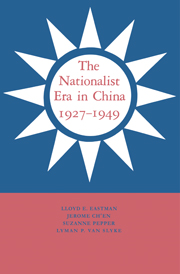Book contents
- Frontmatter
- Contents
- List of maps
- List of tables
- Preface
- Map 1 Provinces of China under the Republic
- Map 2 Republican China–physical features
- Chapter 1 Nationalist China during the Nanking decade, 1927–1937
- Chapter 2 The Communist movement, 1927–1937
- Chapter 3 Nationalist China during the Sino-Japanese War, 1937–1945
- Chapter 4 The Chinese Communist movement during the Sino-Japanese War, 1937–1945
- Chapter 5 The KMT-CCP conflict, 1945–1949
- Bibliography
- Index
Chapter 1 - Nationalist China during the Nanking decade, 1927–1937
Published online by Cambridge University Press: 27 January 2010
- Frontmatter
- Contents
- List of maps
- List of tables
- Preface
- Map 1 Provinces of China under the Republic
- Map 2 Republican China–physical features
- Chapter 1 Nationalist China during the Nanking decade, 1927–1937
- Chapter 2 The Communist movement, 1927–1937
- Chapter 3 Nationalist China during the Sino-Japanese War, 1937–1945
- Chapter 4 The Chinese Communist movement during the Sino-Japanese War, 1937–1945
- Chapter 5 The KMT-CCP conflict, 1945–1949
- Bibliography
- Index
Summary
The Nanking regime was born of factional strife and bloodshed. In the early morning of 12 April 1927, gangs of thugs belonging to the Mafia-like Green Gang plunged through the streets of Shanghai, seized Communists and suspected Communists, and executed them on the spot with pistols or broadswords. Several thousand were massacred then and during the ensuing month. Chiang Kai-shek had split with the Communists; the first united front was ended. Six days later, on 18 April, the Nationalist government was inaugurated at Nanking.
The challenge confronting the new government was awesome – nothing less than to turn back the tide of national disintegration that, for a century and more, had been washing over the Chinese nation. A central, national government had virtually ceased to exist. Political power had devolved into the hands of regional militarists, ‘warlords’, who too often were unconcerned for the popular welfare and sought only to enhance their wealth and power by reliance on military force. The sense of moral community – the broad and pervasive consensus regarding the values and proper relationships of cultural and social life, which had so richly contributed to the stability of traditional China – had disintegrated, and in its place were confusion and contention. Even the economic foundations of the traditional political system had eroded.
THE INITIAL CONSOLIDATION OF POWER
Because the Chinese were profoundly sensitive to the abject condition of their nation, to the ravages of warlord struggles, and to the humiliations of imperialist aggression, the Nationalist revolutionary armies had been greeted exultantly as their Northern Expedition moved from Canton in the south (beginning in July 1926) to Peking in the north (occupied in June 1928) (see volume 12).
- Type
- Chapter
- Information
- The Nationalist Era in China, 1927–1949 , pp. 1 - 52Publisher: Cambridge University PressPrint publication year: 1991
- 7
- Cited by



